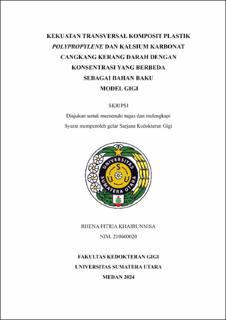| dc.contributor.advisor | Harahap, Kholidina Imanda | |
| dc.contributor.author | Khairunnisa, Rhena Fitria | |
| dc.date.accessioned | 2025-04-23T07:49:18Z | |
| dc.date.available | 2025-04-23T07:49:18Z | |
| dc.date.issued | 2024 | |
| dc.identifier.uri | https://repositori.usu.ac.id/handle/123456789/103338 | |
| dc.description.abstract | The dental model is a replica of real teeth used outside the oral cavity.
Currently, educational tools in dentistry use factory-made tooth models made of
resin, which differ in mechanical properties from real teeth and may limit students’
skill development. The composite of polypropylene (PP) plastic and calcium
carbonate (CaCO3) offers a new approach to dental model materials. This study
aims to determine the transverse strength of PP and CaCO3 composites made from
blood clam shells (Anadara granosa) with varying concentrations as potential
materials for dental models. This study used three formulations with different to-PP
CaCO3 ratios: (I) 75:25, (II) 83:17, and (III) 88:12. The composite samples
measured 65x10x2 mm, with each formulation consisting of 10 samples. The clam
shells were boiled in acetic acid for 1 hour at 100°C, dried in an oven at 100°C for
20 minutes, and ground using a blender. A particle size analysis showed that the
CaCO3 particles measured 0.35 μm. The PP plastic was melted at 160°C for 20
minutes, then manually mixed with CaCO3 powder on an electric stove at 150°C
until homogeneous. The mixture was poured into a mold made of type IV die stone
gypsum and pressed with a hydraulic press at 60 psi for 5 minutes. The samples
were then polished. The transverse strength test was conducted using a universal
testing machine with the three-point bending method and analyzed using one-way
ANOVA. The highest transverse strength was found in type II at 57.06±1.30 MPa,
followed by type III at 50.42±1.01 MPa, and type I at 48.83±2.32 MPa. The oneway
ANOVA results showed a significant difference in transverse strength (p<0.05)
with p=0.0001. In conclusion, the composite with the highest transverse strength
was type II, with a ratio of 83:17, followed by types III and I. | en_US |
| dc.language.iso | id | en_US |
| dc.publisher | Universitas Sumatera Utara | en_US |
| dc.subject | Polypropylene | en_US |
| dc.subject | calcium carbonate | en_US |
| dc.subject | dental models | en_US |
| dc.title | Kekuatan Transversal Komposit Plastik Polypropylene dan Kalsium Karbonat Cangkang Kerang Darah dengan Konsentrasi yang Berbeda sebagai Bahan Baku Model Gigi | en_US |
| dc.title.alternative | Transverse Strength of Polypropylene Plastic and Calcium Carbonate Composite from Blood Clam Shells with Varying Concentrations as a Raw Material for Dental Models | en_US |
| dc.type | Thesis | en_US |
| dc.identifier.nim | NIM210600020 | |
| dc.identifier.nidn | NIDN0011098205 | |
| dc.identifier.kodeprodi | KODEPRODI12201#Pendidikan Dokter Gigi | |
| dc.description.pages | 76 Pages | en_US |
| dc.description.type | Skripsi Sarjana | en_US |
| dc.subject.sdgs | SDGs 3. Good Health And Well Being | en_US |


